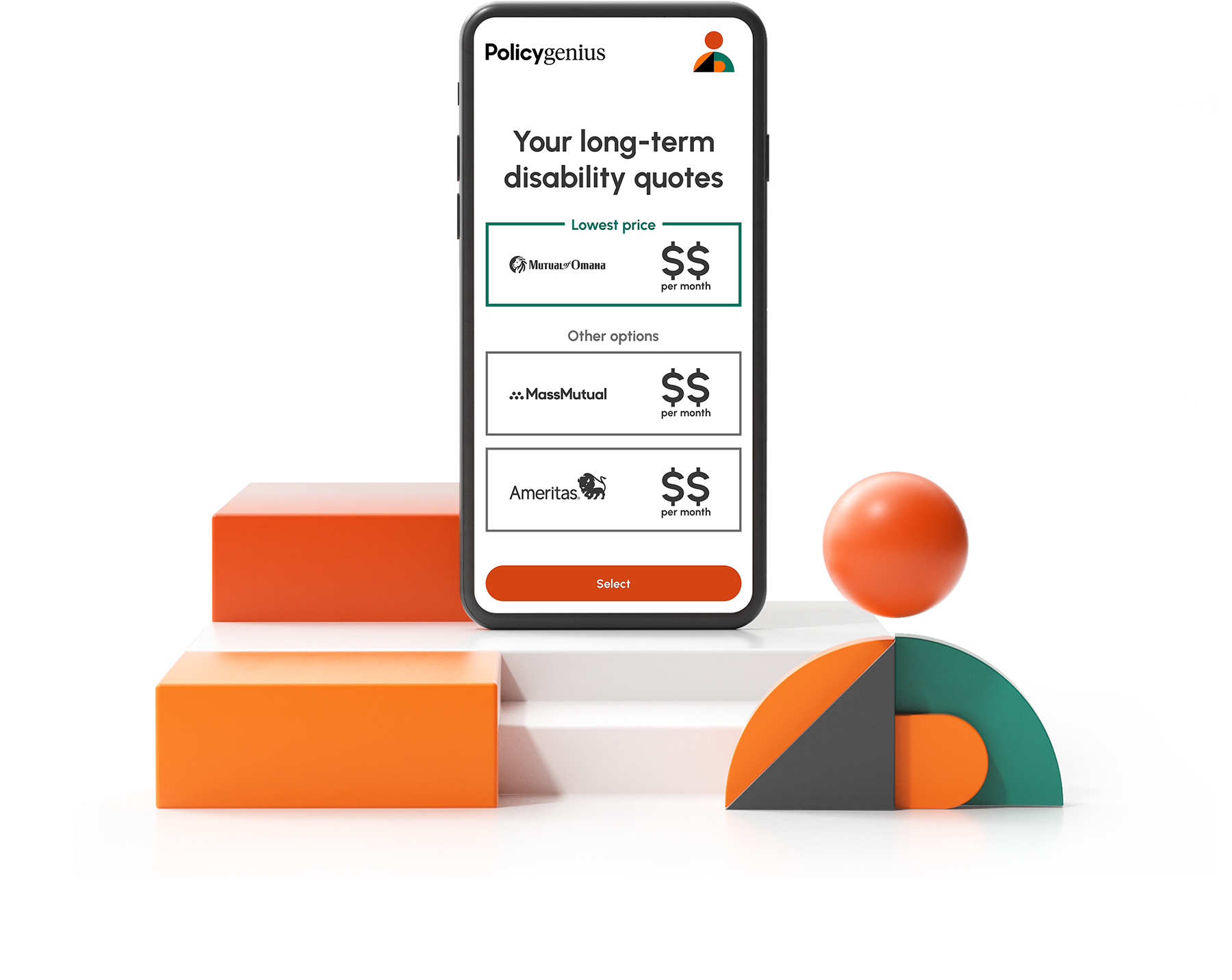What is long-term disability insurance and how does it work?
Think of long-term disability insurance as insurance coverage for your future income. Hopefully you’ll never need to use it, but in case you’re hurt or sick and can’t work for a year or more, it pays out regular benefits that you can use for whatever you need.
You can even get a policy that will pay out for the rest of your working life if you’re never able to go back to your job after an illness or injury.
Long-term disability insurance usually replaces 60 to 80% of your salary, and, depending on the terms of your policy, may continue paying out benefits even if you can go back to work in a different field.
You can use your long-term disability insurance benefits just like a regular paycheck, on things like:
Mortgage payments
Car payments
Childcare
Utility bills
Medical bills
Groceries
Where can I get disability insurance?
You can get disability insurance through your work as an employee benefit or you can buy a private policy just like with other types of insurance.
But the disability insurance you get through work is typically short-term coverage that only covers absences of up to one year, not long-term coverage, and it’s tied to your employer so you can’t keep it when you change jobs.
If you’re a high earner or you have a specialized job that requires a lot of training, it’s probably a good idea to get a private long-term disability insurance policy — the more you make or the more you’ve invested in your career, the more you stand to lose.
What does long-term disability insurance cover?
Long-term disability insurance covers most types of injuries and illnesses that would keep you from work, including:
An illness that causes you to lose your sight
Severe anxiety or depression that makes it impossible to do your job
Complications from pregnancy or childbirth
Nerve damage from a medical condition that makes it hard to use your fingers
Worsening heart disease that makes it impossible to stay at work all day
A sports injury that leads to chronic back pain
There are some exclusions to every long-term disability policy — illnesses or injuries that aren’t covered. Disability insurance doesn’t cover pre-existing conditions, meaning anything that was already diagnosed before you bought the policy. It also won’t cover self-inflicted injuries, or injuries you got while doing something illegal.
Long-term disability insurance in action
Let’s say that you fall off a ladder and break several bones in your arm and hand.
Doctors tell you that your injury will heal, but that you’ll have nerve damage in your hand that will prevent you from continuing to work as a surgeon. You have long-term, own occupation disability insurance so it will fully replace your after-tax income even if you find a different job, up to age 65.
You make a claim and wait for your long-term policy’s six-month long elimination period to end (that’s the amount of time that you have to wait before receiving benefits). While you wait, you make a claim for short-term benefits through the policy you get from your job.
After a while, you receive an offer to teach students who are preparing to become surgeons. Since you have own-occupation long-term disability insurance, you can teach and still continue receiving benefits.
Who should get long-term disability insurance?
You may need long-term disability insurance if you have a high-paying job or a career that requires lots of schooling or training and you want to protect that investment. Careers that make for good long-term disability candidates include:
But disability insurance can be useful no matter what your job is. Losing your income and not being able to pay bills or support your family can lead to long-term financial consequences. About 67% of all U.S. bankruptcies and more than half of all foreclosures stem from illness or injury-related medical issues, according to the American Journal of Public Health. [1]
And a disability may be more likely than you think. More than 1 in 4 workers become disabled before they retire (most often from an illness, not an injury). On average, the disability lasts more than three months.
Long-term disability insurance vs. other types of disability insurance
Long-term disability insurance provides the most protection over the longest time, but there are other types of disability insurance that you might want in addition to long-term coverage.
Short-term disability insurance: Short-term disability insurance is similar to a long-term policy, except coverage lasts up to a year at most. You can use short-term disability insurance before your long-term policy kicks in.
Employee-sponsored disability insurance: You may get disability insurance through your work as an employee benefit. But it’s usually short-term coverage, and it’s tied to your continued employment.
Social Security Disability Insurance: You can get Social Security Disability Insurance (SSDI) through the government if you qualify. Even though it’s free, qualifying can be hard and benefits are very low compared to other types of disability insurance.
How to get long-term disability insurance
There are seven steps to getting long-term disability coverage:
How much does disability insurance cost?
Long-term disability insurance usually costs between 1% and 3% of your annual salary.
Generally speaking, rates get higher when you increase the benefits (meaning the payments) you would get from a long-term disability insurance policy. Basically, the higher your income, the more you'll pay for long-term disability insurance to cover it.
Annual salary | Cost of long-term disability insurance |
|---|---|
$75,000 | $63 to $188 per month |
$100,000 | $83 to $250 per month |
$125,000 | $104 to $313 per month |
$150,000 | $125 to $375 per month |
$175,000 | $146 to $438 per month |
$200,000 | $167 to $500 per month |
$225,000 | $188 to $563 per month |
$250,000 | $208 to $625 per month |
$275,000 | $229 to $688 per month |
$300,000 | $250 to $750 per month |
Who has the best long-term disability insurance?
The best long-term disability insurance company depends on your occupation, where you live, how much and what kind of coverage you need, and other factors.
Some companies specialize in providing long-term disability insurance to certain types of workers or to people earning some amount of money, while others are better for people with manual jobs. Here are some of our top picks for the best long-term disability insurance:
Company | BBB rating | AM Best score | What we like about it … |
|---|---|---|---|
A+ | A | Includes a survivor benefit for your beneficiary. | |
A+ | A- | Partially reimburses your COBRA medical payments if you lose your job health insurance benefits because of a disability. | |
A+ | AA+ | Offers lifetime continuous benefits for total disabilities, even after the policy expires. | |
Illinois Mutual | A+ | A- | Specializes in coverage for people with manual jobs. |
A | A++ | Offers a future insurability rider that's good until your 60th birthday. | |
Petersen | A+ | A | Covers people who would otherwise be considered high risk because of their jobs or health. |
A+ | A+ | Offers a lump-sum payment of $62,400 in addition to regular benefits if you're presumptively disabled. | |
A+ | A | Includes a family care benefit if you have to take time off to care for a sick loved one. |
If you’re not sure how to pick a disability insurance policy, a licensed agent at Policygenius can help you find the best long-term disability insurance company.




